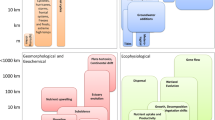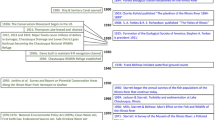Abstract
Because of the interdiscriplinary requirements of studies of river-floodplain systems, development of this field in the United States has been slow, and much information needed for watershed and river-basin planning is not available. This is particularly true in the southwestern United States, where study has been further complicated within the last 50 years by the introduction and spread of saltcedar (Tamarix chinensis)which has occurred simultaneously with other independently generated environmental changes.
The spread of saltcedar has been aided both by purposeful planding and by a fortuitous combination of events that has weakened the native ecosystem at the time that seeds of the new species have been made available, events that possibly include changes in such environmental parameters as flood frequency, channel stability, the season of the peak annual flood, water temperature and salinity, and sediment grain size. Careful research is needed to unravel and understand the network of relationships involved.
Phenomena are arranged in chains of necessary sequence. … If we examine any link of the chain, we find it has more than one antecedent and more than one consequent. … Antecedent and consequent relations are therefore not merely linear, but constitute a plexus; and this plexus pervades nature.
Similar content being viewed by others
References cited
Baum, B. R., 1967. Introduced and naturalized tamarisks in the United States and Canada. Quart. Jour. Hort. Taxonomy, v. 15, n. 1, p. 19–25.
Bryan, K., and G. M. Post, 1927, Erosion and control of silt on the Rio Puerco, New Mexico: Unpublished report to the Chief Engineer, Middle Rio Grande Conservancy District, Albuquerque.
Burkham, D. E., 1976, Hydraulic effects of changes in bottomland vegetation on three major floods, Gila River in southeastern Arizona: U.S. Geol. Survey Prof. Paper 655-J, 14 p.
Campbell, C. J., and W. A. Dick-Peddie, 1964. Comparison of phreatophyte communities on the Rio Grande in New Mexico: Ecology, v. 54, n. 3, p. 492–502.
Campbell, C. J., and W. Green, 1968, Perpetual succession of stream channel vegetation in a semiarid region: Jour. Arizona Acad. Sci., v. 5, 86–98.
Decker, J. P., 1961, Salt secretation byTamarix pentandra pall: Forest Sc., v. 7, n. 3, p. 214–217.
Dietz, R. A., 1952. The evolution of a gravel bar: Missouri Botan. Garden Ann., v. 39, p. 250.
Eakin, H. M., 1936, Silting of reservoir: U.S. Department of Agriculture Tech. Bull. 524, 153 p. (Revised in 1939 by C. B. Brown.)
Everitt, B. L., 1968. Use of cottonwood in an investigation of the recent history of a flood plain: Amer. Jour. Sci., v. 266, p. 417–439.
Everitt, B. L., 1970, A Survey of the desert vegetation of the Northern Henry Mountains Region, Hanksville, Utah: unpubl. Ph.D. dissert., Johns Hopkins University, 190 p.
Everitt, B. L., (in press), Plant ecology of the riverbank:in The lower canyons of the Rio Grande, a natural area survey. University of Texas, Austin.
Gary, H. L., 1965, Some site relations in three flood-plain communities in central Arizona: Jour. Arizona Acad. Sci., v. 3, n. 4, p. 209–212.
Gilbert, G. K., 1886, The inculcation of the scientific method by example, with and illustration drawn from the Quartenary geology of Utah: Amer. Jour. Sci., v. 131 (3rd series), n. 31, p. 284–299.
Gould, F. W., 1969, Texas plants: A checklist and ecological summary: Texas A&M Univ., Agricultural Expt. Sta. Paper MP-585, revised, 121 p.
Grozier, R. U., 1965, Growth of saltcedar in the Pecos River near the New Mexico-Texas boundary; U.S. Geol. Survey Prof. Paper 525-B, p. B175-B176.
Harris, D. R., 1966, Recent plant invasions in the arid and semiarid southwest of the United States: Ann. Assoc. Amer. Geog. v. 65, n. 3, p. 408–422.
Horton, J. S., and C. J. Campbell, 1974, Management of phreatophyte and riparian vegetation for maximum multiple use values: U.S. Dept. Agriculture Forest Service Res. Paper RM-117, 23 p.
Horton, J. S., F. C. Mounts, and J. M. Kraft, 1960, Seed germination and seeding establishment of phreatophyte species: U.S. Dept. Agriculture Forest Service Res. Paper RM-48, 17 p.
International Boundary and Water Commission, U.S. and Mexico (1955), Flow of the Rio Grande and related data: Summary Water Bull.
Johnson, W. C., R. L. Burgess, and W. R. Keammerer, 1976, Forest overstory vegetation and environment on the Missouri River floodplain in North Dakota. Ecol. Monog. v. 46, n. 1, p. 59–84.
Larner, D. C., R. M. Marshall, A. E. Phluger, and S. C. Burnitt, 1974, Woody phreatophytes along the Colorado River from southeast Runnels County to the headwaters in Borden County, Texas: Texas Water Development Board Rept. 182, 19 p.
Merkel, D. L., and H. H. Hopkins, 1957, Life history of saltcedar: Trans. -Kansas Acad. Sci., v. 60, n. 4, p. 360–369.
Potter, L.D., 1975, Shoreline ecology of Lake Powell: Paper presented to the Annual Meeting of the Geological Society of America, Salt Lake City, Utah.
Robinson, T. W., 1958, Phreatophytes: U.S. Geol.Survey Water-Supply Paper 1423, 85 p.
Robinson, T. W., 1965, Introductions, spread, and aerial extent of saltcedar (Tamarix) in the Western States: U.S. Geol. Survey Prof. Paper 491-A, 12 p.
Turner, R. M., 1974, Quantitative and historical evidence of vegetation changes along the Upper Gila River: Arizona, U.S. Geol. Survey Prof. Paper 655-H, 20 p.
Van Hylckama, T. E. A., 1966, Effect of soil salinity on the loss of water from vegetated and fallow soil:in Water in the unsaturated zone: Proc. Interntl Assoc. Sci. Hydrology, p. 634–644.
Warren, D. K., and R. M. Turner, 1975, Saltcedar seed production, seedling establishment, and response to inundation: Arizona Acad. Sci. Jour., v. 10, p. 131–144.
Zimmerman, R. C. 1969, Plant ecology of an arid basin, Tres Alamos—Reddington area, southeastern Arizona: U.S. Geol. Surgery Prof. Paper 485-D, 55 p.
Author information
Authors and Affiliations
Rights and permissions
About this article
Cite this article
Everitt, B.L. Ecology of saltcedar—A plea for research. Geo 3, 77–84 (1980). https://doi.org/10.1007/BF02473474
Issue Date:
DOI: https://doi.org/10.1007/BF02473474




